#Western Sumatran Rhino
Explore tagged Tumblr posts
Text
A Sumatran rhino has been born in western Indonesia, officials said Monday, a rare sanctuary birth for the critically endangered animal with only several dozen believed to be left in the world. The World Wide Fund for Nature (WWF) and the International Union for Conservation of Nature (IUCN) estimate the population of Sumatran rhinos to number less than 80 on the Indonesian islands of Sumatra and Borneo. A female rhino named Delilah gave birth to a yet-to-be-named male calf weighing 25 kilograms (55 pounds) at Way Kambas National Park in Sumatra over the weekend, fathered by a rhino called Harapan. It was the fifth calf born under a semi-wild breeding program at the park, Indonesian Environment and Forestry Minister Siti Nurbaya Bakar said in a statement. The new addition to the Sumatran rhino herd at Way Kambas, which numbers 10, comes after another baby Sumatran rhino was born there in September.
Continue Reading.
219 notes
·
View notes
Text






























Save The Rhino Day
Save the Rhino Day, celebrated globally on May 1, is a day centered around raising awareness of the rhino’s plight in the world, and highlighting ways to help this incredible animal. This day is especially important given the current devastating statistics — on average, one rhino is poached somewhere in the world every 22 hours. On this day, various animal rights organizations, non-profit companies, zoos, animal activists, and other concerned groups provide opportunities to encourage more rhino conservation efforts from people around the world.
History of Save The Rhino Day
To trace the origins of the Rhinoceros, we’d have to go back some millennia — almost 56 million years ago, to be precise. That’s when the first ancestors of the modern Rhinos roamed the planet. They were more horse-like in structure and had no horns. Old rhino bones found from this period in North America show a gradual evolution from this old horse-like structure into one more aligned with today’s rhino. Over these years, there were three distinct species that scientists think might be the ancestors of today’s rhinos. One of these was called the ‘running rhino,’ which was adapted for speed.
Another was more aquatic and resembled today’s hippopotamus. The last, most direct ancestors to the modern rhinoceros appeared approximately 25 million years ago and had multiple sub-species in their families. Of these, the wooly rhinoceros was one of the largest subspecies, weighing in at almost four times the size of the average African elephant, and boasting one-meter-long horns. This species inhabited a large area, from Siberia to the British Isles. These plant-eaters lived alongside the wooly mammoths, and have been found fossilized in ice and in cave paintings made during that period.
These rhinos only lived in Asia initially but began traveling to other places around 25 million years ago. Over time, these rhino ancestors roamed the continents, primarily living in Eurasia (Europe and Asia combined) and North America. However, the American rhinos went extinct sometime between 5.4 and 2.4 million years ago.
Rhinos have also featured in many Asian and African legends — they are the fire-stamping heroes in many stories from Burma, India, and Malaysia. According to these stories, rhinos appeared every time a fire was lit in the forest and would stamp out the flames. So popular is this tale that it even featured in a popular 1980 South-African movie named “The Gods Must Be Crazy.”
Unfortunately, these once-abundant creatures have lost out to human activity. Hunting, and now, poaching and habitat loss, have drastically reduced the number of rhinos across the world. Rhino horns are also integral to traditional medicine in many parts of Asia, with people believing it has mystical powers. Since 2007, there has been a sharp increase in poaching activity and illegal trade of rhino horns, to the extent that many subspecies of rhinos have been declared extinct and the entire rhino population is listed as ‘endangered’.
Save The Rhino Day timeline
1973
A Symbol of Queer Identity
Two Boston artists, Daniel Thaxton and Bernie Toale create a lavender rhinoceros as a symbol to increase awareness of gays and lesbians and put it in a series of subway posters.
2011
No More Black Rhinos
The Western Black Rhino — which used to live in Cameroon, Chad, the Central African Republic, Sudan, and South Sudan — is declared extinct because of excessive poaching.
2012
A Ray of Hope
For the very first time, a Sumatran rhino — the smallest of the rhino family — is born in captivity in the Sumatran Rhino Sanctuary in Indonesia; this miracle repeats in 2016, and then in 2022.
2018
A Sad Farewell
The world bids goodbye to the last known male northern white rhino; only two females survive to this day.
Save The Rhino Day FAQs
What day is World Rhino Day?
On September 22 each year, the global community celebrates the rhinoceros and explains what people can do to help them.
How many rhino species are there?
At present, there are five species of rhinos in the world — the white rhino and the black rhino (both found in Africa), and the Indian, Javan, and Sumatran (all found in Asia).
Are rhinos endangered?
The black, Javan, and Sumatran rhinos are still listed as ‘critically endangered,’ while the entire species is classified as ‘endangered.’
How to Observe Save The Rhino Day
Learn about the rhinoceros: Uncover more interesting information about this magnificent animal. Watch documentaries featuring the rhino, read books and other literature about them, and discover more studies and research that show just how the rhino lives.
Visit a rhino: Why not go see a rhinoceros in real life? Check out rhinos at a local zoo or plan a trip to visit rhinos in the wild.
Help save the rhino: Research the efforts various groups make towards saving the rhino, and check out what you can do to help. These could include online volunteering services, donations of funds, and more.
5 Fun Facts About The Rhinoceros
The rhino communication method: Rhinos make funny sounds — like snorting, sneeze-like sounds, and even honking — and use their bodily waste to 'speak' to other rhinos.
They don't have 20-20 vision: Rhino eyesight is notoriously poor, so much so that if an animal only 100 feet away — in an open space, too — stood motionless, the rhino wouldn't be able to spot them.
How the white rhino got its name: This rhino isn't actually white — English explorers mistook the Afrikaans 'wyd,' which refers to the huge girth of this animal, as 'white' and the name stuck.
Their horns are like our nails: Rhino horns are made up almost entirely of keratin, which is also the protein found in human hair and nails.
And still, people steal their horns: Even as rhino horns are proven to have no health benefits, signs in museums — like the National Museum of Scotland — notify visitors that the horn on display is a replica, as the real one has been stolen.
Why Save The Rhino Day is Important
It helps increase awareness: Rhinos are becoming increasingly rare in the wild, and only continuous efforts to raise awareness, like celebrating Save The Rhino Day, can help this endangered species. Do your bit today to support rhinos.
Creating safe havens for rhinos: The spike in awareness such days provide also subsequently raises the amount of help being offered to save the rhinos. These increased efforts could help secure various safe and protected spaces for the rhino to survive and thrive.
Building a rhino-loving community: Conservation efforts have had a significant impact in the past — various subspecies of rhinos have seen their numbers gradually increase over the years as a result of these activities. After these celebrations, we are left with a passionate and motivated global community that wants to see the rhinoceros flourish in the decades to come.
Source
#Southern white rhinoceros#Grévy's zebra#Lewa Savanne#indoors#outdoors#summer 2023#Zoo Zürich#day trip#animal#travel#original photography#tourist attraction#landmark#cityscape#architecture#landscape#Zurich#Schweiz#Switzerland#Save The Rhino Day#SaveTheRhinocerosDay#SaveTheRhinoDay#1 May
3 notes
·
View notes
Note
🌿 🦖 🎧 🙃 📷
🌿 Describe your favorite outfit.
:) I'm in my awareness-about-clothes era! 💀 everything I had before the year 2022 was either my mother's, bought by my mother, or bought WITH my mother. ANYWAY
My favorite outfit is probably this new eggshell satin top that looks a bit Shakespearen with drawstring neckline and long sleeves, paired with chocolate-brown corduroy midwaist trousers. 🕯
HOWEVER I also have this cute soft-wool crop top that's a gradient of violet, lilac, and light pink that goes with my black high-rise. 🌆
HOWEVER I adore this lightweight short-sleeved stretchy black dress with a loose belt that ends just mid-calf and letting my hairy legs breathe. 🖤
HOWEVER there's also this pair of high-rise light blue-washed jeans that I wear with a belt and any black top from cropped T-shirt with silver star on it to long-sleeved mid-crop buttoned blouse, HOWEVER -
(I stick to like one pair of cream-colored sneakers. I have 3 other pairs for running and jogging and badminton respectively)
🦖 Favorite extinct animal?
I had to look this one up, bec the only extinct animals I remember is the Sumatran Rhino (in my country; the Sumatran Rhino is not extinct in other parts of Asia) and Javan tiger.
Honestly this was kinda sad to answer, but it's a tie between the Western Black Rhinoceros from Africa and the Little Blue Macaw from Brazil. There are still some of the latter in captivity, though, so maybe there's hope there.
🎧 Headphones or earbuds?
I studied a course that specialized in sound engineering back in college, so I'm definitely a headphones woman. But also I've never liked the way earphones tend to beam audio directly to your eardrums (not that I ever spent much on earphones, so maybe that's why?)
Honestly these days I'm more of a sit-alone-in-a-room-and-use-the-speakers woman.
🙃 What’s a weird fact that you know?
Not only do stars (red giants I think) have nearby planets for a last meal before they die, there's a strong theory that that's how planet Earth is gonna go out billions of years in the future - feeding our Sun. 🍽
📷 What’s set as your phone’s lockscreen?
It's just a theme-linked illustration of a cloud with stars and planets hanging from it (like a mobile) and the cloud has a rainbow in it. Thing is, I have an animated lockscreen so there's all this twinkling and shooting stars too ☁🌈✨
2 notes
·
View notes
Text

Instagram Store
Western Sumatran Rhinoceros
The first time I knew about the existence of this animal, I was 9 years old. It wasn't a photograph but an illustration and I was completely astonished that an animal that resembles prehistoric times was still among us. I finally saw a photograph when I was about 15. There wasn't any internet at that time so access to things was entirely through books. One of my wishes in life is to see one of these ones in person but knowing its precarious situation, the hope to see one fades a little every day. The Western Sumatran Rhinoceros is the most numerous of all the three subspecies with no more than 80 individuals. This subspecies was the last one to inhabit a zoo. The Cincinnati Zoo. The animal left the zoo in 2015 to return to Indonesia in order to start a reproduction program that has brought some success but nothing significant.
However, one female calf was born this year (2022), which brings some hope to the preservation of the species. ___________________________________________ References: Sumatran_rhinoceros Photo Credit: David Ellis.
____________________________________________
If you like the content please follow my blog. A like, reblog, or comment is very much appreciated.
#Western Sumatran Rhino#sumatran rhino#illustration#drawing#rhinoceros#rhino#scientific illustration#illo#wild animals#wildlife#animals#mammals#animal#artist on tumblr#rhino horns#inforgraphics#conservatioin#recently extinct#extinción#extinct animals
31 notes
·
View notes
Text
On soil degradation and the use of non-native plants as weapons to change landscapes and sever cultural relationships to land; and on the dramatically under-reported but massive scale of anthropogenic environmental change wrought by early empires and “civilizations” in the Bronze Age, Iron Age, and ancient world (including the Fertile Crescent, Rome, and early China): I didn’t want to add to an already long post.

This is a Roman mosaic, from when Rome controlled Syria, depicting an elephant (presumably the Asian species, Elephas maximus) interacting with a tiger (the Caspian tiger, a distinct subspecies of tiger, lived in Mesopotamia, the shores of the Black Sea, and Anatolia up until the mid-1900s). This mosaic is striking to me, because I guess you could say that this is clear evidence of the higher biodiversity and more-dynamic ecology of the Fertile Crescent in the recent past, until expanding militarism and empire led to extensive devegetation. After all, does the popular consciousness really associate elephants and tigers with the modern-day eastern Mediterranean and Anatolia? Not really. But for the majority of human existence, lions, tigers, elephants, and cheetah were all living alongside each other in Mesopotamia. Pretty cool.
Anyway, I wanted to respond to this:

Which was in response to a thing I posted:
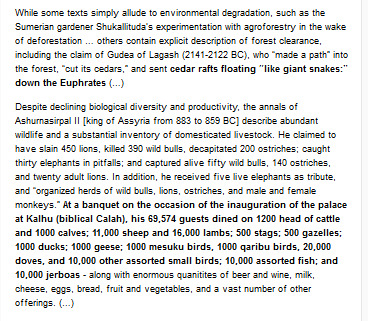
Pina: Thanks for the addition! I don’t know much about the technicality Rome’s devegetation of the Mediterranean periphery, but - like you - I’ve read some cool articles about it, and then forgotten to bookmark them. (I know that I have at least one good article in print form, about Roman devegetation; I’m going to try to find it.) I’m glad you mentioned it!

The first image is in the public domain and depicts a rhino-shaped ritual wine vessel made of bronze, from about 1100 to 1050 BC, during the Shang era. (The piece is housed at the Asian Art Museum of San Francisco.) The second image is another bronze wine vessel from a site in Shaanxi Province, this time inlaid with gold and hailing from later in history during the Western Han period, about 205 BC to 10 AD. (Photo by Wikimedia user Babel/Stone.) The rhinos in both of these pieces are depicted with two horns, meaning that they likely depict the Sumatran rhinoceros; this is corroborated by the existence of fossil remains of Sumatran rhinos from across China prior to 1000 AD.
On devegetation in the ancient world:
Yes, it feels like the ecological effects of empires prior to the Middle Ages are not just “under-discussed,” but dramatically overlooked. Some “quintessential and iconic African fauna” like lions and cheetahs lived throughout the Fertile Crescent, until devegetation during the late Bronze Age and, a few centuries later, the ascent of Rome. Caspian tigers (a distinct subspecies of tiger) also lived nearby, in Anatolia, the Caucasus, the shores of the Black Sea, and Persia - right up until the 20th century, in fact! (Other iconic species present on the periphery of ancient Mesopotamia were Asian elephants; leopards are still present.) Aside from the devegetation of the Fertile Crescent and the later landscape modifications of Rome, I also don’t see a lot of popular discussion (there is academic discussion, though, obviously) of ecological change in Zhou-era and early imperial China, either. While early Mesopotamia is famous for the amount of social prestige ascribed to irrigators and engineers, who were evidently essential to maintaining the domesticated crops so important to “hydraulic civilization,” early China (apparently) also revered irrigators and engineers. At least according to folklore and written histories, before the Han period, seasonal floods, especially in the Yangtze watershed, would regularly destroy human settlements. Also, there far more tigers, leopards, rhinos, and elephants present; rhinos and elephants lived as far north as the Yellow River until empire really expanded, and the animals lived as far north as the Yangtze River into the European Renaissance era. So, those people with the technical expertise to “tame the wilderness” by damming rivers or calming floodwaters were given prestige and sometimes treated as folk heroes. [Chinese history is not a subject that I really know a lot about. I’m just relaying the observations made in one of the better books on environmental history in East Asia, which is Mark Elvin’s The Retreat of the Elephants - 2006.]

------
On empires’ use of soil degradation to “sever connections to land” and “indirectly” destroy alternative or resisting cultures:
Seems that empire uses ecological degradation to enact a “severing of relations” (in Zoe Todd’s words). Basically: If you destroy somebody’s gardens, then they have to come to you to buy food. Furthermore, destroying someone’s connection to land will also harm their cultural traditions rooted in that land, eliminating a threat to the imperial cultural hegemony and erasing “alternative possibilities and futures” from the collective imaginary. (And destroying the imagination doesn’t just harm the invaded cultures, it also prevents the relatively privileged people living in the metropole or imperial core from “achieving consciousness” or whatever, wherein someone living in 150 AD Rome or 1890s New York City might imagine an alternative system and potentially dismantle the empire from within.)
It’s violence; destroying soil, cutting forests, it’s violence. But when empires destroy soil, they get to maintain a little bit of plausible deniability: “Ohhh, it’s not like we outright killed anybody, we just accidentally degraded the soil and now you can’t grow your own food. Damn, guess you have to rely on our market now, which also means you have to assimilate/integrate into our culture.”
Europe, the US, and the World Bank did this in West Africa after “independence.” They said “oh, yea, sure, we’ll formally liberate you from colonial rule.” But since the palm and sugar plantations were already installed, and many of the ungulate herds of the savanna had already been killed, what were new West African nations supposed to do? Miraculously resurrect the complex web of microorganism lifeforms in the soil? So what the US and its proxies are essentially doing is saying: “If you want loans, you have to keep the plantations and also install supermarkets to sell Coca-Cola.”
Todd: “The Anthropocene as the extension and enactment of colonial logic systematically erases difference, by way of genocide and forced integration and through projects of climate change that imply the radical transformation of the biosphere. Colonialism, especially settler colonialism – which in the Americas simultaneously employed the twinned processes of dispossession and chattel slavery – was always about changing the land, transforming the earth itself, including the creatures, the plants, the soil composition and the atmosphere.” [Heather Davis and Zoe Todd. “On the Importance of a Date, or Decolonizing the Anthropocene.” ACME An International Journal for Critical Geographies. December 2017.]
-----
On the use of non-native plants as a sort of “biological weapon”:
The use of non-native plants and agriculture to enforce colonization and empire is the whole focus of this influential book from Alfred Crosby. (I have some issues/criticisms of some of his work/theories, but his work is generally interesting.) Crosby popularized the term “neo-Europes,” and he proposes that European empires attempted to subjugate the native ecology of landscapes in Turtle Island, Latin America, Australia, etc., while attempting to introduce European species, cattle ranches, pastures, dairy farms, gardens, etc. in an effort to “recreate” a European landscape.

-----
Speaking of Rome’s devegetation of the Mediterranean: One of the famous cases of Roman devegetation that made the rounds recently was that of silphium. A couple of excerpts:

[From: The Original Seed Pod That May Have Inspired the Heart Shape This historical botanical theory has its roots in ancient contraceptive practices.” Cara Giaimo for Atlas Obscure, 13 February 2017.]
Silphium, which once grew rampant in the ancient Greek city of Cyrene, in North Africa, was likely a type of giant fennel, with crunchy stalks and small clumps of yellow flowers. From its stem and roots, it emitted a pungent sap that Pliny the Elder called “among the most precious gifts presented to us by Nature.”
According to the numismatist T.V. Buttrey, exports of the plant and its resins made Cyrene the richest city on the continent at the time. It was so valuable, in fact, that Cyrenians began printing it on their money. Silver coins from the 6th century B.C. are imprinted with images of the plant’s stalk -- a thick column with flowers on top and leaves sticking out -- and its seed pods, which look pretty familiar:

[End of excerpt.]
Silphium is extinct now. There is a lot of conjecture about what, specifically, caused the extinction. But it looks like the expansion of Rome across the North African coast of the Mediterranean, and Rome’s development leading to soil degradation, is a likely cause.
-----
Thanks @pinabutterjam :3
The scale of ecological imperialism’s effects ... planetary, no escape. It’s exhausting.
1K notes
·
View notes
Text
Cows might become the largest mammals on land in 200 years, thanks to humans
Humans have been causing the largest mammals on land to go extinct for thousands of years.

So visit your nearest zoo soon while you and your kids can still see the elephants, giraffes, lions and tigers. They're disappearing fast, and odds are your great- great-grandchildren will never be able to see a live rhino, snow leopard, or polar bear. There most likely won't be enough elephants or giraffes left for each zoo to have a few. The Western Black Rhino was declared extinct in 2011.
Not all of these are large mammals, but they are all examples of creatures we are pushing toward extinction.


Three of the nine subspecies of giraffes are now in serious trouble and considered “critically endangered.” The threats facing giraffes include illegal hunting and civil unrest in parts of Africa and habitat loss due to mining and agriculture.

There are only about 60 Amur Leopards left in the wild (in eastern Russia).

There are perhaps 275 Sumatran Rhinos left in the entire world. Only 2 captive females have reproduced in the past 15 years.

I couldn't help but include this little guy... The Ili pika (Ochontana iliensis) is a small mammal in the Tianshan mountain range of China that was just discovered in 1983. Its numbers have declined by 70% since then; there are less than 1,000 left.
Read the full article here.
1 note
·
View note
Text

A rhinoceros commonly abbreviated to rhino is a member of any of the five extant species of odd-toed ungulates in the family Rhinocerotidae. Two of the extant species are native to Africa, and three to South and Southeast Asia.

Did you know🦏The five extant species ⁉️
🦏 The white rhinoceros is actually grey. There are two subspecies of white rhinoceros: the southern white rhinoceros (Ceratotherium simum simum) and the northern white rhinoceros (Ceratotherium simum cottoni).
🦏The black rhinoceros has a beak shaped lip and is similar in color to the white rhinoceros. There are four subspecies of black rhino: South-central (Diceros bicornis minor), the most numerous, which once ranged from central Tanzania south through Zambia, Zimbabwe and Mozambique to northern and eastern South Africa; South-western (Diceros bicornis occidentalis) which are better adapted to the arid and semi-arid savannas of Namibia, southern Angola, western Botswana and western South Africa; East African (Diceros bicornis michaeli), primarily in Tanzania; and West African (Diceros bicornis longipes) which was declared extinct in November 2011.
🦏The Indian rhinoceros, or greater one-horned rhinoceros, (Rhinoceros unicornis) has a single horn 20 to 60 cm long. It is nearly as large as the African white rhino. Indian rhinos once inhabited many areas ranging from Pakistan to Myanmar and maybe even parts of China.
🦏The Javan rhinoceros (Rhinoceros sondaicus) is one of the most endangered large mammals in the world. According to 2015 estimates, only about 60 remain, in Java, Indonesia, all in the wild. It is also the least known rhino species.
🦏The Sumatran rhinoceros (Dicerorhinus sumatrensis) is the smallest extant rhinoceros species, as well as the one with the most hair. It can be found at very high altitudes in Borneo and Sumatra. Due to habitat loss and poaching, their numbers have declined and it has become the second most threatened rhinoceros. There are three subspecies of Sumatran rhinoceros: the Sumatran rhinoceros proper (Dicerorhinus sumatrensis sumatrensis), the Bornean rhinoceros (Dicerorhinus sumatrensis harrissoni) and the possibly extinct Northern Sumatran rhinoceros (Dicerorhinus sumatrensis lasiotis).

To learn more please contact us and book your vacation of a lifetime. √ See more 👉 www.kim.tours 🌍 via @kimzebraadventuressafaris #kimzebraadventuressafaris
0 notes
Text
WildEyes ™ AI: Helping to Protect Wild Rhinos from Poachers and Track Species Recovery
On World Rhino Day 2020, RESOLVE and CVEDIA announce a novel solution to protect the world’s endangered rhinoceros species from extinction in the wild and to better monitor their recovery efforts. This new low-cost technology allows real-time detection of rhinos and illegal intruders, and transmits images as alerts to protection forces to prevent the slaughter of defenseless rhinos. Using new advances in artificial intelligence technology, RESOLVE’s tiny camera system, called WildEyes™ AI, works remotely, hidden from the poacher’s gaze. When the camera’s motion sensor is triggered, it uses computer vision to detect rhinos or humans in the frame and transmits those images in near-real time to the smartphones of rangers, park directors at Headquarters, and other designated parties to afford greater transparency in reporting. Placed strategically along suspected poacher trails, the cameras send alerts to command posts, which can trigger a rapid response by park authorities to protect these rare animals and arrest poachers trying to set snares or shoot rhinos. A major challenge to protection efforts is that several of the rhino species are territorial and sparsely distributed over large areas, and thus harder to patrol effectively. Many of these parks are underfunded and struggle to keep ranger staff paid and properly equipped, and the COVID-19 crisis has exacerbated these difficulties. What is needed now is new technology to serve as a “force multiplier”, where a staff of 150 rangers can be as effective as 1,500 by responding within minutes to near-real time alerts of entry by poachers and to stop the poachers before they kill.
This new technology cannot come soon enough. Although international rhino horn trade has been banned under CITES since 1977, rhinos in Africa and Asia continue to be persecuted for their horns, which are reported to be valued at $65,000 per kilogram in illicit Asian markets. Many populations of the five species have suffered precipitous declines due to relentless poaching in the past few decades. Combined across all species, perhaps no more than 30,000 wild rhinos are alive today. The last wild northern white rhinos were hunted to extinction in 2018 and the Sumatran rhino has disappeared from the island of Borneo and is now restricted to three small populations in Sumatra. The Javan rhino may be the rarest large mammal on Earth, limited to a single park in western Java and numbering under 75 individuals. Less than 3,700 greater one-horned rhinos and only about 5,000 black rhinoceros remain in the wild. Only the southern white rhino occurs in numbers estimated at 22,000 individuals across about 467 populations.
How it Works: The sophisticated AI algorithm detects both humans and rhinos. The detector is based on synthetic data models created by CVEDIA, running on the Intel Movidius vision processing unit (VPU) embedded in the WildEyes AI camera. The camera remains asleep until the motion sensor is triggered and then, leveraging the AI algorithm, the Intel VPU filters out false triggers. The images can be sent from the camera to either the cell network or via a radio link in areas lacking cell coverage, to the Internet, and back to park HQ in about 2 minutes. By filtering “on the edge” (i.e., only transmitting true positives of rhinos or humans), the camera conserves vital battery life. Due to the VPU’s low power requirements, WildEyes AI can run for more than 1.5 years on a single charge of its small rechargeable Lithium Ion battery—a game changer for a field-based sensor.
“This wildlife camera system can detect rhinos and those who seek to do them harm. With the tremendous partnership and support of Intel and CVEDIA engineers, we can contribute to reducing one of the world’s most pressing wildlife management problems—to stop the poaching of rhinos to extinction,” said Steve Gulick, inventor of TrailGuard AI and its offshoot, WildEyes AI and Chief Technology Officer of WildTech@RESOLVE.
Enhancing Monitoring of Rhinos: WildEyes AI, running the Rhino Detector, has another important application: monitoring rhino recovery. Current monitoring approaches for endangered large mammals rely on radio-telemetry, field observations, and aerial surveys, but are resource intensive; their limitations are much more pronounced in dense forested or grassland environments where the three Asian species reside. Among the five rhino species, only the body shape of the Greater one-horned rhinoceros allows it to be fitted with a traditional radio collar. For the black rhino and white rhino of Africa, transmitters have to be placed in the horn, but these are short-lived. More effective is to place WildEyes AI cameras running the rhino detector at water holes where the African species congregate, or at forest wallows where the Asian species meet and cool off. To retrieve and process data from the field creates a lag time between event and detection, ranging from weeks to months. A network of cameras running the CVEDIA rhino detector strategically positioned within rhino home ranges can autonomously detect rhinos 24/7 with high accuracy and near real-time notification capabilities, an affordable alternative to traditional surveys or to support existing monitoring efforts. For very small populations, such as for the Sumatran and Javan rhinos that live in dense tropical forests, photo-ID would greatly advance protection and population estimation.
“I wish there had been a technology like WildEyes AI when I was conducting a photographic-based census of rhinos in Chitwan National Park in Nepal in the late 1980s. Rhinos are easy to tell apart compared to most large mammals: a combination of horn size and shape, cuts to the ears and other scars, and extra skin folds distinguish rhinos as individuals. Soon, we will also be able to run Re-Identification algorithms to determine if a specific rhino has been previously detected by the camera’s software. This will be a revolution in monitoring these endangered species,” said rhino biologist Dr. Eric Dinerstein, co-inventor of TrailGuard AI and WildEyes AI, Director of the project at RESOLVE, and author of The return of the unicorns: the natural history and conservation of the greater one-horned rhinoceros and the chapter on rhinoceroses in the Lynx Encyclopedia Handbook of the Mammals of the World.
“By combining our advanced human detector with the new rhino detector, we can have a big impact on protecting endangered rhinos. Using our unique approach to creating AI algorithms trained on synthetic data, in under three weeks, we were able to create a detection algorithm with high accuracy that processes using very low power inside the camera itself. Our Rhino Detector is trained on all five species of rhino so it is agnostic to the species. Because range overlap is rare, or non-existent in most parks, classifying rhinos by species is not of concern in this use case. We’re excited about our partnership with RESOLVE and are just getting started: detectors for other high-value wildlife species such as elephants, tigers, snow leopards, wolves, and bears, have already been developed and soon we will create regional detectors and classifiers for multiple species to run on the edge,” Arjan Wijnveen, CEO of CVEDIA.
Release of the WildEyes AI cameras running the CVEDIA rhino+human detector will begin in November 2020. This work was supported by grants from the Shared Earth Foundation, the Stadler Family Foundation, the Weeden Family Foundation, and One Earth Philanthropy.
About RESOLVE
RESOLVE is a Washington, DC-based non-profit organization that forges sustainable solutions to critical environmental, social, and health, challenges by creating innovative partnerships where they are least likely and most needed. RESOLVE’s Biodiversity and Wildlife Solutions Program tackles the most pressing conservation problems of our time—the approaching extinction of endangered wildlife and threats to habitats, including tropical forests where most of the world’s species reside—through technological innovation, ambitious global agreements, and targeted land protection.
About CVEDIA
CVEDIA is an AI solutions company creating machine learning algorithms for applications where data is limited or unavailable. We’ve mastered synthetic data for computer vision, using a combination of data science and machine learning against a backdrop of 3D design.
source: https://www.csrwire.com/press_releases/45814-WildEyes-AI-Helping-to-Protect-Wild-Rhinos-from-Poachers-and-Track-Species-Recovery?tracking_source=rss
0 notes
Photo

On World Rhino Day, held on 22 September each year, we celebrate the five species of rhinoceros, and the unique characteristics of each.
Black rhinos (Diceros bicornis) are known for being particularly elusive making them hard to study and track. Researches using video surveillance were able to learn about the fecal scraping habits of black rhinos which provide insights into scent-marking behaviors.
The white rhino (Ceratotherium simum) is the largest of the rhinoceros species weighing between 1,800-2,500 kg.
The greater one-horned rhino (Rhinoceros unicornis) consumes a diet consisting of up to 183 different plants with a strong seasonal variation: grass, fruits, leaves and branches of trees and shrubs, aquatic plants, and agricultural crops. They eat an average 1% of their body weight daily, and are known to swim for their food.
The Javan rhino (Rhinoceros sondaicus) exists in a single population in Ujung Kulon peninsular, western Java, Indonesia leading to speculation it is the rarest large mammal on Earth.
Sumatran rhino (Dicerorhinus sumatrensis) also known as the hairy rhino, has been on earth longer than any other living mammal.
One commonality between the species has been population decline due to habitat loss and overhunting. Rhinos are targeted for poaching due to the value of their horns and demand for them. As the populations dwindle, conservation efforts by the very humans that threaten their existence will play an important role in future generations celebrating these majestic creatures.
Image: Rhino by Gellinger. CC0 public domain via Pixabay.
#world rhino day#rhinos#mammals#black rhinos#endangered species#Rhinoceros#poaching#conservation#Journal of Mammalogy#Mammalian Species#Oxford journals#biology#life science#BioScience
110 notes
·
View notes
Text
The World's Most Famous Valleys
10. Valley of the Ten Peaks (Canada)
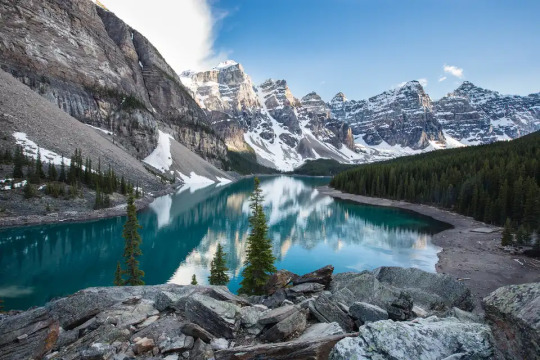
The Valley of the Ten Peaks is located in Banff National Park in the western province of Alberta. It is aptly named for the ten snow-capped mountains so magnificently reflected in the blue, mirrorlike surface of Moraine Lake. Measuring approximately 3,424 meters high, Deltaform Mountain is the tallest of the ten behemoths. What part of the valley floor is not filled with water is covered in dense forest that many critters call home. The Valley of the Ten Peaks is such an iconic representation of Canadian wilderness that it used to feature on the back of their twenty dollar bill.
9. Yosemite Valley (United States)

Stretching approximately 7.5 miles, Yosemite Valley is located in the Sierra Nevada mountain range of Central California. Formed by glaciers over thirty million years ago, it is most famous for its sheer granite cliffs. Rock climbers come from all over to challenge these monolithic beasts, particularly El Capitan which rises nearly a thousand meters above the ground. Blanketed in shadow, these rock formations turn blue at night. Less dangerous hiking trails offer casual tourists gorgeous panoramic views of lush forests and green meadows. The valley is also home to countless waterfalls, including Yosemite Falls, the highest waterfall in North America.
8. Kalalau Valley (United States)

Kalalau Valley is located on the Hawaiian island of Kaua‘i. Surrounded by cliffs measuring more than 610 meters high, this natural hideaway is often referred to as Kaua‘i's Cathedral and is only accessible by foot, kayak, or helicopter. The sun and frequent rain have transformed this valley into a thriving paradise where flora grows along the steep cliffs and fauna live within the forests and surrounding hills. At the end of the trail cutting through the greenery, mangoes, passion fruit, and cherries grow next to a waterfall. Because of its designation as a state park, nobody is permitted to live in Kalalau Valley.
7. Valle de la Luna (Chile)

Valle de la Luna—or Valley of the Moon—is a part of the Atacama Desert in the South American country of Chile. The bleak landscape is composed of various rock formations carved by strong wind and sand. Numerous dry lakes and caverns dot the region. It is considered to be one of the driest places in the world, with some parts last receiving rain hundreds of years ago. Because of this, there is little wildlife to be found there. As its name implies, it is famous for resembling a barren moonscape. In fact, a prototype of the Mars rover was tested in the valley due to its unique lunar-like terrain.
6. Lauterbrunnen Valley (Switzerland)

Located deep in the Swiss Alps, Lauterbrunnen Valley is one of the biggest nature conservation areas in Switzerland. Known for its 72 waterfalls, its very name means “many fountains.” The most famous is Staubbach Falls, which at 300 meters, is one of the highest free-falling waterfalls in Europe. Tourists can walk through wildflower meadows and clusters of trees in full view of snow-capped mountains, breathing in the fresh valley air. It is also a popular skiing region in the winter. The surrounding area is so picturesque that Lord of the Rings author J.R.R. Tolkien modeled the Elven kingdom of Rivendell after Lauterbrunnen Valley.
5. Valley of Flowers (India)

The Valley of Flowers is a high-altitude Himalayan valley located in the state of Uttarakhand. Rising over 3,000 meters above sea level and stretching across 87.50 square kilometers of land, it is known as one of the most beautiful and peaceful places in India. Revered by both mountain climbers and botanists alike, the valley is blanketed with alpine wildflowers. From mid-July to September, hikers can wander among the bursts of purples, pinks, and blues. The region is also alive with incredible wildlife, from Asiatic bears to the Himalayan blue sheep. In 2002, the Valley of Flowers was declared a UNESCO World Heritage Site.
4. Barun Valley (Nepal)

Barun Valley is located in the Himalayas in the Asian country of Nepal. It is situated at the base of Mount Makalu, the fifth-highest mountain in the world, and contains some of the world’s last untouched ecosystems. Among the forests, waterfalls, and wild orchids roam rare animals such as musk deer and the endangered snow leopard. It is such a mystical-looking paradise that it is known in Buddhist folklore as a place where no one ages. According to ancient religious literature, Barun Valley will be one of seven places left in the world where life can thrive in the wake of a global cataclysmic event.
3. Jiuzhaigou Valley (China)

The Jiuzhaigou Valley is a nature reserve and national park in the Sichuan Province of China. Spanning 720 square kilometers, it is a breathtaking region known for its many lakes and springs. A local legend tells the story of how the Goddess Semo dropped a mirror made of wind and clouds that shattered to create the countless lakes that dot the valley. The most impressive is Five Flower Lake, an ethereal paradise where ancient tree trunks swim among the cyan water. The region is also home to many endangered animals, including the giant panda and the Sichuan takin. Tourists can accompany guides on daily hikes or set up camp for a few days.
2. Danum Valley (Borneo)

The Danum Valley is a conservation area in Borneo, the largest island in Asia. Relatively undisturbed by human interference, this 438-square kilometer tract of land is mainly tropical rainforest, which grants it a misty, almost eerie quality. It is home to some of the world’s most astonishing creatures, such as pygmy elephants, East Sumatran rhinos, gibbons, and mousedeer. The valley offers tourists the opportunity to trek through the jungle or swim in its many rivers. With over 300 species of birds, it is also a fabulous spot for bird watching. Efforts have been made to nominate the valley as a UNESCO World Heritage Site.
1. Valley of Geysers (Russia)
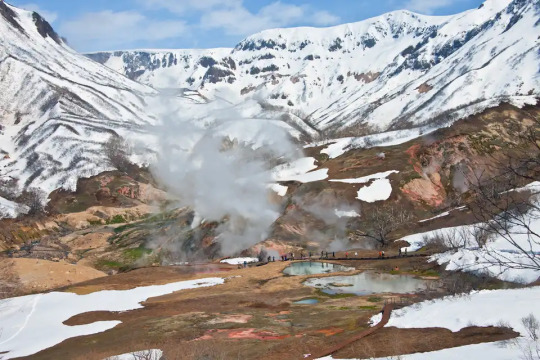
The Valley of Geysers is located in the Russian Far East, approximately 25 miles from the Pacific Ocean. The basin itself stretches 3.7 miles and is considered one of the most important geographic discoveries of the twentieth century. Perhaps unsurprisingly, it is famous for containing the second-largest concentration of geysers in the world. These ninety or so geysers can be as hot as 480 degrees Fahrenheit. They are surrounded by lush green vegetation, but tourists are only permitted to visit the main geysers along the pre-marked safe paths. The valley is only accessible by helicopter.
1 note
·
View note
Photo
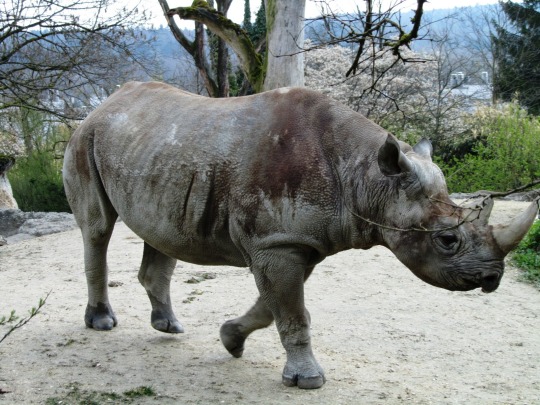
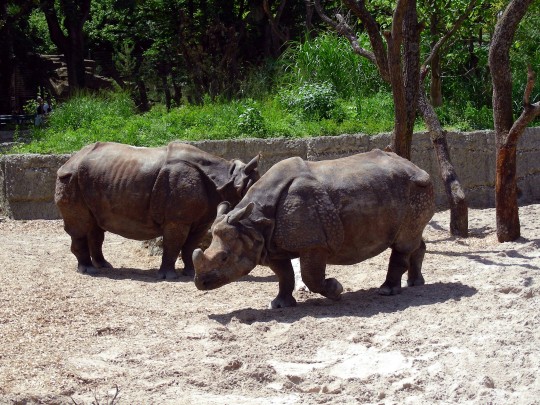




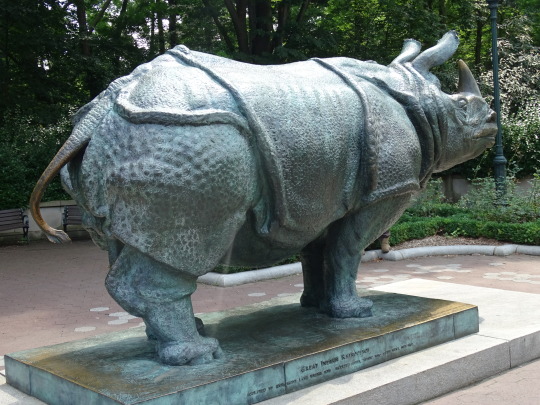
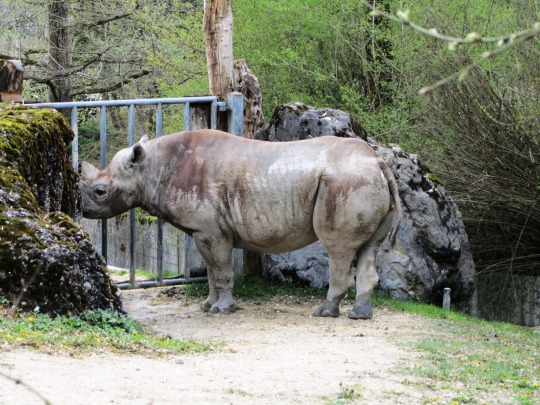


Save The Rhino Day
Save the Rhino Day, celebrated globally on May 1, is a day centered around raising awareness of the rhino’s plight in the world, and highlighting ways to help this incredible animal. This day is especially important given the current devastating statistics — on average, one rhino is poached somewhere in the world every 22 hours. On this day, various animal rights organizations, non-profit companies, zoos, animal activists, and other concerned groups provide opportunities to encourage more rhino conservation efforts from people around the world.
History of Save The Rhino Day
To trace the origins of the Rhinoceros, we’d have to go back some millennia — almost 56 million years ago, to be precise. That’s when the first ancestors of the modern Rhinos roamed the planet. They were more horse-like in structure and had no horns. Old rhino bones found from this period in North America show a gradual evolution from this old horse-like structure into one more aligned with today’s rhino. Over these years, there were three distinct species that scientists think might be the ancestors of today’s rhinos. One of these was called the ‘running rhino,’ which was adapted for speed.
Another was more aquatic and resembled today’s hippopotamus. The last, most direct ancestors to the modern rhinoceros appeared approximately 25 million years ago and had multiple sub-species in their families. Of these, the wooly rhinoceros was one of the largest subspecies, weighing in at almost four times the size of the average African elephant, and boasting one-meter-long horns. This species inhabited a large area, from Siberia to the British Isles. These plant-eaters lived alongside the wooly mammoths, and have been found fossilized in ice and in cave paintings made during that period.
These rhinos only lived in Asia initially but began traveling to other places around 25 million years ago. Over time, these rhino ancestors roamed the continents, primarily living in Eurasia (Europe and Asia combined) and North America. However, the American rhinos went extinct sometime between 5.4 and 2.4 million years ago.
Rhinos have also featured in many Asian and African legends — they are the fire-stamping heroes in many stories from Burma, India, and Malaysia. According to these stories, rhinos appeared every time a fire was lit in the forest and would stamp out the flames. So popular is this tale that it even featured in a popular 1980 South-African movie named “The Gods Must Be Crazy.”
Unfortunately, these once-abundant creatures have lost out to human activity. Hunting, and now, poaching and habitat loss, have drastically reduced the number of rhinos across the world. Rhino horns are also integral to traditional medicine in many parts of Asia, with people believing it has mystical powers. Since 2007, there has been a sharp increase in poaching activity and illegal trade of rhino horns, to the extent that many subspecies of rhinos have been declared extinct and the entire rhino population is listed as ‘endangered’.
Save The Rhino Day timeline
1973 A Symbol of Queer Identity
Two Boston artists, Daniel Thaxton and Bernie Toale create a lavender rhinoceros as a symbol to increase awareness of gays and lesbians and put it in a series of subway posters.
2011 No More Black Rhinos
The Western Black Rhino — which used to live in Cameroon, Chad, the Central African Republic, Sudan, and South Sudan — is declared extinct because of excessive poaching.
2012 A Ray of Hope
For the very first time, a Sumatran rhino — the smallest of the rhino family — is born in captivity in the Sumatran Rhino Sanctuary in Indonesia; this miracle repeats in 2016, and then in 2022.
2018 A Sad Farewell
The world bids goodbye to the last known male northern white rhino; only two females survive to this day.
Save The Rhino Day FAQs
What day is World Rhino Day?
On September 22 each year, the global community celebrates the rhinoceros and explains what people can do to help them.
How many rhino species are there?
At present, there are five species of rhinos in the world — the white rhino and the black rhino (both found in Africa), and the Indian, Javan, and Sumatran (all found in Asia).
Are rhinos endangered?
The black, Javan, and Sumatran rhinos are still listed as ‘critically endangered,’ while the entire species is classified as ‘endangered.’
How to Observe Save The Rhino Day
Learn about the rhinoceros
Visit a rhino
Help save the rhino
Uncover more interesting information about this magnificent animal. Watch documentaries featuring the rhino, read books and other literature about them, and discover more studies and research that show just how the rhino lives.
Why not go see a rhinoceros in real life? Check out rhinos at a local zoo or plan a trip to visit rhinos in the wild.
Research the efforts various groups make towards saving the rhino, and check out what you can do to help. These could include online volunteering services, donations of funds, and more.
5 Fun Facts About The Rhinoceros
The rhino communication method
They don't have 20-20 vision
How the white rhino got its name
Their horns are like our nails
And still, people steal their horns
Rhinos make funny sounds — like snorting, sneeze-like sounds, and even honking — and use their bodily waste to 'speak' to other rhinos.
Rhino eyesight is notoriously poor, so much so that if an animal only 100 feet away — in an open space, too — stood motionless, the rhino wouldn't be able to spot them.
This rhino isn't actually white — English explorers mistook the Afrikaans 'wyd,' which refers to the huge girth of this animal, as 'white' and the name stuck.
Rhino horns are made up almost entirely of keratin, which is also the protein found in human hair and nails.
Even as rhino horns are proven to have no health benefits, signs in museums — like the National Museum of Scotland — notify visitors that the horn on display is a replica, as the real one has been stolen.
Why Save The Rhino Day is Important
It helps increase awareness
Creating safe havens for rhinos
Building a rhino-loving community
Rhinos are becoming increasingly rare in the wild, and only continuous efforts to raise awareness, like celebrating Save The Rhino Day, can help this endangered species. Do your bit today to support rhinos.
The spike in awareness such days provide also subsequently raises the amount of help being offered to save the rhinos. These increased efforts could help secure various safe and protected spaces for the rhino to survive and thrive.
Conservation efforts have had a significant impact in the past — various subspecies of rhinos have seen their numbers gradually increase over the years as a result of these activities. After these celebrations, we are left with a passionate and motivated global community that wants to see the rhinoceros flourish in the decades to come.
Source
#Great Indian Rhinoceros by Katharine Lane Weems#Bronx Zoo#New York City#Indian rhinoceros#Zoo Zürich#Zoo Basel#Zolli#Lincoln Park Zoo#Chicago#USA#Schweiz#Switzerland#sculpture#outdoors#original photography#travel#summer 2018#vacation#day trip#Save The Rhino Day#SaveTheRhinocerosDay#SaveTheRhinoDay#1 May
2 notes
·
View notes
Link
The Leuser Ecosystem on the island of Sumatra in Indonesia thrums with life. It is an ancient, 6.5 million acres of lush rainforest and steamy peat swamps, and because of its rich biodiversity, is one of the most important rainforests still standing today.
Its clear rivers provide drinking water for millions of people and its lowland and mountainous rainforests are literally the last place on earth where Sumatran elephants, orangutans, tigers, rhinos and sunbears still coexist in the wild. Globally, we all depend on it for the climate regulating effects such a large carbon-sink can have.
And yet, the Leuser Ecosystem is being actively destroyed for palm oil and other industries.
A new field investigation released by Rainforest Action Network exposes how one company is pumping conflict palm oil—palm oil connected to the clearance of tropical rainforests and the destruction of carbon-rich peatlands—into the global marketplace. The conflict palm oil coming out of the Leuser Ecosystem is shipped to the major brands whose products line store shelves the world over.
Palm oil has quickly become the most widely used vegetable oil in the world. It can be found in every room of the house, in products ranging from potato chips to laundry detergent, ice cream to cosmetics, and cookies to cooking oil. The boom in palm oil has been driven, in part, by a demand in Western countries for shelf-stable vegetable oils, used to replace the hydrogenated oils now despised for their transfats.
However, the palm oil industry is rife with issues, and conflict palm oil still dominates the market. Child labor, human trafficking, land grabbing, rainforest deforestation, endangered species habitat destruction and massive forest fires are all connected to the production of conflict palm oil.
This latest report is the second time RAN has blown the whistle on this company. The palm oil company, PT. Agra Bumi Niaga (PT. ABN), was first outed for clearing rainforest in the Leuser Ecosystem—despite an Indonesian-wide moratorium on forest clearance for new palm oil development—in a RAN field report in February 2017.
In this first report, RAN exposed both PT. ABN, the mill PT. ABN was supplying palm oil to, and the companies buying palm oil from that mill—major palm oil traders that supply many of the world’s major snack food brands with the palm oil that is used in their products.
This latest field investigation found that PT. ABN continued to clear forests even after it was first exposed, and simply moved its palm oil to a new mill, a few miles up the road from the first. And those major traders supplying palm oil to the rest of the marketplace were buying palm oil from this mill as well.
The palm oil company PT. ABN operates a 2,000-hectare plantation in the Leuser Ecosystem, on land that is known habitat for the Sumatran tiger and the critically endangered Sumatran elephant and orangutan. Indonesia’s Environment and Forestry Ministry’s own field assessment of the plantation––conducted in June 2016, as the Ministry was officially closing the plantation because it did not have a proper permit—recorded 22 Sumatran elephants living on the plantation itself.
Despite this, satellite images show that PT. ABN has reduced the area covered by forests from 420 hectares in June 2016, to a mere 88 hectares in April 2017.
After its first mill was exposed, PT. ABN switched to supplying palm oil from this concession to a mill called PT. Ensem Sawita, five miles up the road from the previous one. Supplier mill lists and maps published by six of the world’s largest palm oil traders—Wilmar, Musim Mas, Golden Agri-Resources (GAR), Cargill, IOI and ADM—show that PT. Ensem Sawita has a track record of supplying palm oil to refineries, including in the U.S., Canada, and Europe, which in turn supply all of the world’s largest traders and global brands. Just those six traders alone are believed to have a combined palm oil market share of well over 60 percent.
This latest report shows that the biggest global brands, such as PepsiCo, McDonald’s, Nestle, Unilever, Kellogg’s, Mars and Procter & Gamble and many more, are connected to this single deforestation event through their sourcing of palm oil from these palm oil traders.
As reported in The Guardian, a representative for the mill, PT. Ensem Sawita, confirmed the findings of the report. Expressing regret for the failure of sourcing from PT. ABN, they claimed confusion over a past name change for the palm oil company, despite the fact that the name change was previously reported as well. Many of the palm oil traders and global brands have corporate policies and commitments in place that are meant to ensure they do not source palm oil connected to deforestation, development on peatlands, or exploitation. Yet time and time again, corporations fail to do the due diligence necessary to ensure conflict palm oil is never a part of the products they sell.
Palm oil is big business. It's found in half of all packaged goods in the average grocery store. RAN’s latest field investigation illuminates the dirty supply chain of palm oil, connecting some of the biggest brands in the world with active bulldozing of endangered elephant habitat in the Leuser Ecosystem. From this one case of ongoing deforestation, plantation company PT. ABN pumped conflict palm oil all over the world, as the graphic below illustrates.
Some companies are working to solve the problem with palm oil, including those working with the Palm Oil Innovation Group, which demonstrates that truly responsible palm oil is possible. Responsible palm oil is produced without the destruction of rainforests and sensitive peatland areas and also upholds labor and human rights. Through the combined pressure of groups like POIG, international and local NGOs, and concerned consumers, the palm oil industry will hopefully reform itself, before it's too late.
But companies must do more. RAN’s latest report exposes the actors involved in, or profiting from, the destruction of the Leuser Ecosystem. Despite the wave of “No Deforestation” commitments that have been made by countless corporations, the global palm oil supply chain remains tainted with conflict palm oil grown at the expense of the Leuser Ecosystem.
If more immediate action is not taken to enforce “No Deforestation” policies, these brands will be remembered as the corporate giants responsible for the destruction of the last place on earth where Sumatran elephants, orangutans, rhinos and tigers roamed side by side.
Voice your concern. Tell PepsiCo, Nestlé, Unilever, Mars, Kellogg’s, McDonald’s and Procter & Gamble to put elephants over profits and end the destruction of the Leuser Ecosystem.
Emma Rae Lierley is the forest communications manager at Rainforest Action Network.
86 notes
·
View notes
Text

Instagram Store
Eastern Sumatran Rhinoceros.
Also known as the Bornean Sumatran Rhino. According to scientists, this animal is functionally extinct, meaning that the population will be unable to recover. About only 15 individuals exist in the wild. It is the smallest of all three subspecies, making it the smallest among all species of rhinos. Its fur is denser when young but becomes sparse and darker when grows.
The difference between this subspecies and the Western Sumatran Rhinoceros is mainly genetic.
_______________________________________________
Reference: Eastern Sumatran Rhinoceros
_______________________________________________
And with this rhino, I finish all the rhino family. This is my favorite animal and it was so enriching to work on this project because allowed me to know them better and be aware of how close many of them are to extinction (if not already extinct), after having survived millions of years of adaptation through evolution.
Think how sad would be that an animal who has survived the most abrupt changes on earth for thousands of centuries and has shown how strong and adaptative is, will succumb in less than two centuries because of our fault. Thanks again for your appreciation. If you like the content please follow my blog. One animal every week.
#eastern sumatran rhinoceros#Bornean sumatran rhinoceros#sumatran rhinoceros#sumatran rhino#rhino#rhinoceros#conservation#illustration#drawing#scientific illustration#illo#wild animals#wildlife#mammals#artist on tumblr#extinction#ecology#zoology#animals#biodiversity#extinct species#recently extinct
51 notes
·
View notes
Text
Rhinos in China: Though rhinos are currently extinct in China, here are some new-ish maps and research on the surprisingly widespread distribution of rhinoceros species living in China during recent historic times, prior to large-scale human geoengineering and environmental change
*Spins wheel* Uhhh today’s hyperfixation is: distribution maps, just like every day. But this time, it’s maps related to East Asian environmental history and the anthropogenic extinction of rhinos. Or whatever. Have this stupidly long and completely unsolicited post, I guess.
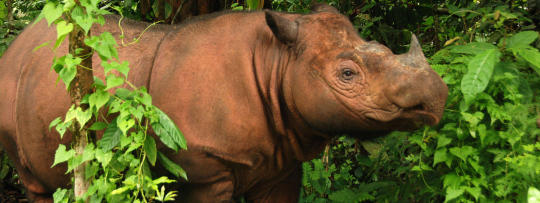
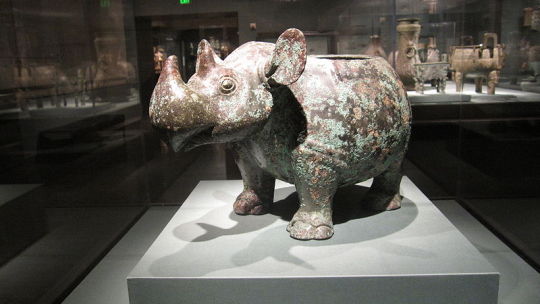
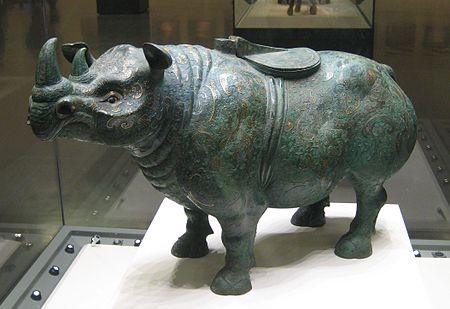
Today, rhinos are extinct in China. The presence of rhinos in China during historical times - and the scale of their distribution range - has been a bit ambiguous, at least to Western/European audiences, though Chinese art and scholarship has long incorporated rhinos. Though modern, living rhinos seem to be associated with tropical and subtropical biomes in the popular consciousness, the Sumatran rhinoceros (Dicerorhinus sumatrensis) apparently didn’t mind the seasonal snow and cold of temperate climates. About only 3,000 years ago, the Sumatran rhino was apparently still present throughout most of China, as far north as modern Beijing; even as recently as 100 AD, this rhino was probably still present as far north as Shanghai.
The phrase “retreat of the elephants” has sometimes been used to describe the process of human-caused environmental change and landscape alteration that dramatically remade the Chinese landscape over the past 3,000 years especially. (”Retreat of the elephants” is a term borrowed from environmental historian Mark Elvin.) It is relatively well-known that Asian elephants (Elephas maximus), which at the beginning of major Chinese state-building and irrigation projects about 3,000 years ago still lived as far north as Beijing, were gradually driven further and further south, away from the Yellow and Yangtze rivers. Recent research, though, shows that Sumatran rhinos also suffered a similar fate. A “retreat of the rhinos” if you will.
The two rhinoceros figurines pictured above are pieces from ancient China. The first image is in the public domain and depicts a rhino-shaped ritual wine vessel made of bronze, from about 1100 to 1050 BC, during the Shang era. The piece is housed at the Asian Art Museum of San Francisco, The second image is another bronze wine vessel from a site in Shaanxi Province, this time inlaid with gold and hailing from later in history during the Western Han period, about 205 BC to 10 AD. [Photo by Wikimedia user Babel/Stone.] The rhinos in both of these pieces are depicted with two horns, meaning that they likely depict the Sumatran rhinoceros; this is corroborated by the existence of fossil remains of Sumatran rhinos from across China prior to 1000 AD. [The header photo above depicts a living Sumatran rhino on the island of Sumatra. Photo by Bil Konstant and International Rhino Foundation.]
Here behold a Sumatran rhino - and a calf! [At Sumatran Rhino Sanctuary on the far southeastern edge of the island. Photo by S. Ellis, via PBS.]
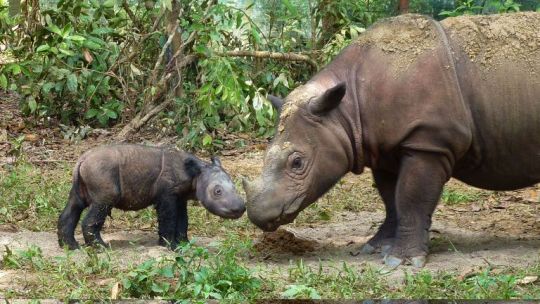
A Sumatran rhino. [Photo by Mark Carwardine and WWF.]
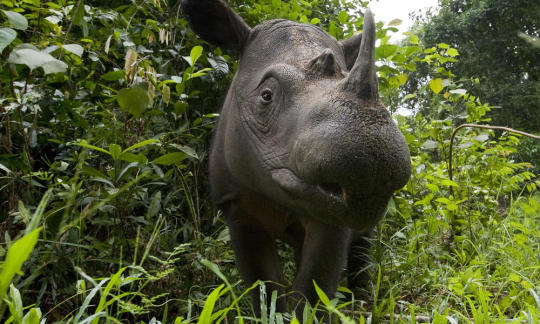
-
Here are some maps and other recent research resources about 3 of the rhinos living in China in recent history.
At the end of the last Ice Age of the Pleistocene about 11,500 years ago and during the advent of so-called agricultural civilization, China was apparently still home to at least 3 species of rhino: the woolly rhinoceros (went extinct around this time); Javan rhinoceros; and, by far the most widespread species, the Sumatran rhinoceros. (To be fair, it is proposed that a 4th species - the famous Indian rhinoceros, Rhinoceros unicornis, now the most relatively stable of the Asian rhino species - was potentially historically present in small pockets of China’s Yunnan Province up until the 20th Century.)
(Rhinos don’t observe arbitrary human-made national borders. I don’t like observing national borders especially when discussing biogeography and ecoregions, so here I’m referring to “China” as the geographic space which was in the cultural sphere of influence of a Chinese dynasty/state between the Shang era and the early 20th Century; centered on the Yellow and Yangtze rivers; and basically including landscapes north of Vietnam, east of Tibet/Taklamakan, and south of the Gobi Desert.)
-
Woolly rhinoceros (Coelodonta antiquitatis)

This is a reconstruction of a woolly rhinoceros, housed at the Natural History Museum in London. Photo by Emoke Denes.
Here’s a distribution map of known sites where woolly rhinos still lived in the Late Pleistocene (up to about 11,500 years ago), at the time that humans were planting and domesticating food crops.

This map comes from a neat report on Late Pleistocene megafauana and ecology in China: “Three abrupt climatic events since the Late Pleistocene in the North China Plain” from Lin Jingxing et al., 2013.
Woolly rhinos may have died out around this same time at the end of the Pleistocene (11,500 YBP), a little too early to have been depicted widely in Chinese art. (Some radiocarbon dates of woolly rhino remains in nearby Siberia, however, suggest the rhino could have persisted into the Holocene until the climatic reversal of the Younger Dryas period, about 10,000 YBP or 8,000 BC.)
-
Javan rhinoceros (Rhinoceros sondaicus)
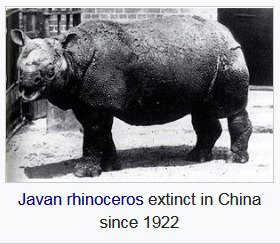
[Thank you, Wikipedia.]
There are less than 100 Javan rhinos that still exist, living only in Ujung Kulon National Park on the far western tip of Java. Here’s the distribution range of the Javan rhinoceros in recent history before its terrible decline [map by Wikimedia user JayHenry]:
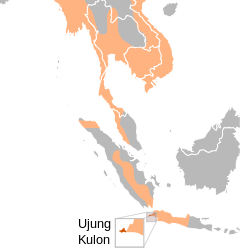
During the past 150 years, the Javan rhino still lived all across Southeast Asia, from India and Bangladesh through Vietnam and into Indonesia. Historically, the Javan rhino likely used to live along the southern China coast west of Guangzhou and Hong Kong. Since the species seems to prefer humid tropical environments, it’s unlikely that the Javan rhino lived any farther north into China during historic times.
-
Sumatran rhinoceros (Dicerorhinus sumatrensis)
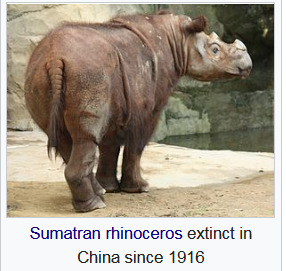
[Thanks again, Wikipedia.]
Here we are. Unlike other rhino species which either went extinct during the Pleistocene or only occupied the humid, tropical southern fringes of China, the Sumatran rhino lived throughout most of China. This is the species likely depicted in historic Chinese art and from which rhino-hide armor was made. Occasional poems from early China also seemingly make reference to the presence of rhinos.
Here’s the current distribution of the Sumatran rhinoceros, contrasted with the early 20th Century distribution [map by Wikimedia user Jay/Henry, adapted from Foose 1997 and Dinerstein 2003]:
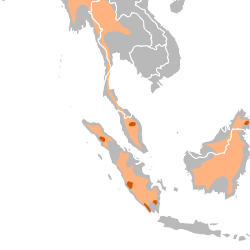
Note that the Sumatran rhino currently lives nowhere near China. Until 1916, the Sumatran rhino had lived in Yunnan Province in far southern China along the Myanmar and Indian borders with China. This map is misleading, however, since the Sumatran rhino was present across the majority of China during “historic” times. Recent Chinese scholarship confirms that the Sumatran rhinoceros was much more widespread across China before 1000 AD.
During the past 3000 years, the Sumatran rhino evidently lived as far north as Beijing, in northern China. Here’s a map of recovered Sumatran rhino fossils throughout China, including an approximation of their distribution range over time.
The real historic distribution of Sumatran rhinos in China:
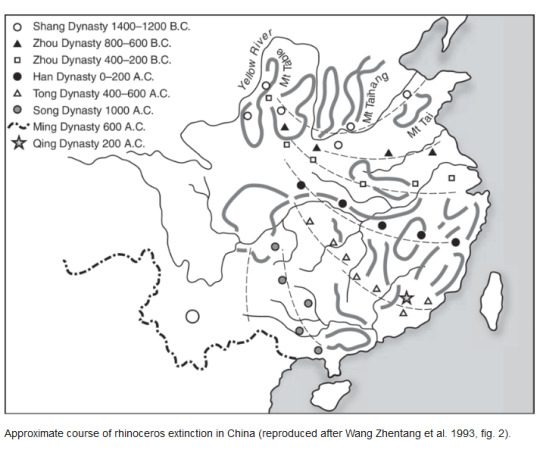
I edited the map a little:
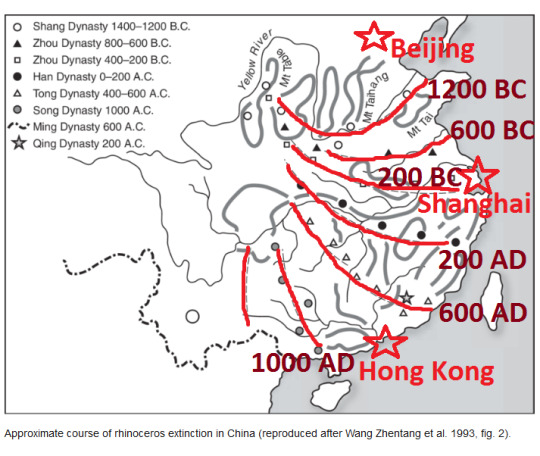
During the Shang era (1400-1200 BC), Sumatran rhinos were still present near Beijing and the Yellow River. By the famous Han Dynasty and the so-called unification of a Chinese “empire” around 50 AD, Sumatran rhinos had been pushed south to about the Yangtze River and Shanghai. By about 1000 AD, the species had been pushed farther south, near Guangzhou and Hong Kong.
This map uses fossil presence of Sumatran rhinos to approximate the historic extent of their distribution in China. The map comes from a great summary of the historic distribution of rhinos in China: “Distribution and extinction of the rhinoceros in China: review of recent Chinese publications” from Kees Rookmaaker, published in Pachyderm, 2006.

[A Sumatran rhino. Photo by Sumatran Rhino Sanctuary via WWF.]
Check out this link to read more about the history of rhinos in China.
Thank you for participating in this hyperfixation.
117 notes
·
View notes
Text
Every forest is a massive carbon sink, but oceans are the primary carbon sequestration mechanism for the planet (via limestones formed from marine snow as plankton dies).
Clear cutting southeast Asian rainforests for palm oil is a far more present danger for one of the most diverse and threatened ecosystems on earth. Palm oil is also a cause for clear cutting in Central America, and Central and West Africa.
Southeast Asia has the highest rate of deforestation on the planet. One study in 2007 said that 98% of Indonesian rainforest will be gone by 2022, due to a combination of palm oil, logging (both legal and illegal), and forest fires. The sumatran rhino is already functionally extinct as a result. South Asian tiger species are hanging on by a thread, and orangutans and Asian elephants are both highly effected. Let alone lesser known species that the average person knows little of (flat headed cats, colugos, hornbills, cuscus, echidnas, banteng, altogether 32% of Indonesia's mammals are endangered).
Either way around it, an American eating beef (almost none of which is imported from the Amazon) does less to harm carbon storage or lead to habitat degradation than that same American using the dozens of daily products containing unsustainable palm oil does.
And my knowledge of the situation is that the biggest threat to carbon storage is oceanic microplastics, which are mostly caused by all of us using polyester and other plastic fibers, as a single load of plastic-based laundry can dump 700,000 pieces of microplastic straight into our water systems.
This is the whole point of the v*gan =/= sustainable. The leading causes of deforestation are plant based foods, the reason the oceans are dying are plastic clothes we started using as alternative to animal fibers. California's drought was worsened by the insane amount of almond production, importing plant foods (ie, bananas) from the tropics off-season makes for a lot of emissions in their transportation.
I live in a desert, where crops don't grow, but beef cattle get by really well on rangeland without disturbing the native environment very much, and eat the invasive grasses that do harm the environment (the grasses combine with drought and pine beetle kill is why the wildfires are getting so much worse in the western US). That's sustainable, trying to grow tomatoes here is not. Avoiding animal products doesn't mean you're helping save the planet.
Just a reminder that v*gan ≠ sustainable. Sustainable is growing things where they’re suited to- goats and other hardy livestock in scrubby areas with poor soil, and definitely not growing avocados and other water-heavy crops in most of California. And also buying and eating local and in season (reduces the impact from shipping foods).
7K notes
·
View notes